October 30, 2025
 by Harshita Tewari / October 30, 2025
by Harshita Tewari / October 30, 2025

Security compliance isn’t simple. Between SOC 2 reports, ISO 27001 audits, and GDPR requirements, even organized teams can end up with scattered evidence and unclear ownership. While I don’t manage security compliance firsthand, I’ve analyzed how real professionals tackle these challenges through G2 Data and verified user reviews.I evaluated over 15 tools to uncover the best security compliance software that helps reduce audit fatigue, automate evidence collection, and maintain readiness year-round. According to G2 reviewers, the best platforms go beyond checklists; they centralize policies, map overlapping controls, and detect issues before they turn into audit risks.
Whether you’re looking for the best security compliance software for small businesses or the most recommended security compliance software for corporate use, I cover all of that and more in this listicle. Each tool in this list reflects what real users say works (and what doesn’t) when it comes to achieving and maintaining compliance across growing frameworks. Let’s get started!
*These security compliance tools are top-rated in their category, according to G2’s Fall 2025 Grid Report. I’ve added their standout features for easier comparison. For pricing details, please contact the sales team directly via their official website.
Security compliance isn’t just about passing audits; it’s about proving your company can be trusted. Even the most organized teams can lose track of ownership and evidence across evolving frameworks, such as SOC 2, ISO 27001, and GDPR.
That’s why more organizations are investing in compliance automation. The security compliance software market, valued at $5 billion in 2025, is projected to reach $15 billion by 2033.
The best security compliance software automates evidence collection, maps overlapping controls, and provides real-time visibility into compliance status. Instead of scrambling before every audit, teams can maintain readiness year-round.
Beyond automation, these tools promote collaboration across security, HR, and legal functions, making compliance a continuous process rather than a one-time event. For growing startups and large enterprises alike, that shift toward always-on compliance is what makes these platforms truly worth it.
I started by analyzing G2’s Grid Report for security compliance software, which ranks products based on user satisfaction and market presence. This helped identify tools consistently recognized by real users.
Next, I used AI-assisted analysis of G2 review data to uncover recurring feedback themes. I focused on what users said about automation accuracy, evidence collection speed, framework coverage, and cross-team collaboration. These insights revealed which platforms deliver measurable time savings and reduce audit friction in real-world scenarios.
To validate those findings, I compared review patterns against peer insights and public documentation. This combination of G2 Data and external research made it easier to separate well-marketed tools from those actually improving compliance outcomes.
All product data and screenshots are sourced from G2 listings and publicly available materials.
I considered the following factors when evaluating the best security compliance software.
The list below contains genuine user reviews from the Security Compliance Software category page. To be included in this category, a solution must:
*This data was pulled from G2 in 2025. Some reviews may have been edited for clarity.
Vanta is one of the highest-rated tools in the category, earning a satisfaction score of 100 on G2. It’s popular among small businesses (57%) and mid-market teams (42%), reflecting its balance of usability and depth. Vanta helps teams simplify compliance and stay continuously audit-ready with automation at every step.
Automated evidence collection is one of Vanta’s strongest features. The platform connects directly to cloud, identity, and productivity tools to collect and validate evidence automatically. This saves security and compliance teams from spending hours tracking screenshots or following up on evidence requests. Many G2 reviewers highlighted how this automation keeps audits organized and reduces the back-and-forth with auditors.
Another widely appreciated feature is its policy templates. It includes a robust library of prebuilt templates aligned with leading security frameworks. G2 reviewers mentioned how these templates make compliance documentation faster and easier to create. They can also be customized to fit organizational processes while maintaining auditor expectations.
The tool’s framework support stood out, too. The platform supports SOC 2, ISO 27001, HIPAA, and GDPR frameworks, giving teams the flexibility to manage all certifications from a unified control environment. Reviewers praised its ability to map overlapping controls, reducing redundant work between frameworks.
The dashboard earned strong praise for giving teams real-time visibility into their compliance posture. Users described it as clean, intuitive, and rich with actionable insights. It highlights control status, open risks, and progress toward audits in a single view. Reviewers also liked how it visualizes compliance trends, helping teams prioritize remediations proactively. For many, this dashboard became their daily source of truth for tracking compliance progress.
Vanta’s integrations add even more value. The platform connects seamlessly with AWS, GitHub, Jira, Slack, and Google Workspace, allowing evidence and alerts to flow between systems automatically. This connectivity helps reduce silos between security, engineering, and compliance teams. Several reviewers said these integrations cut down meeting time and manual follow-ups, making compliance collaboration smoother across departments.
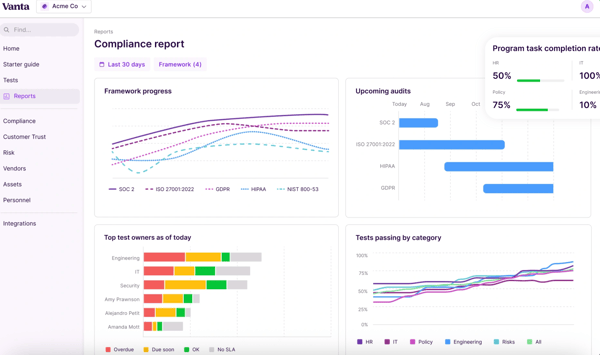
Ease of use is another reason the tool stands out. G2 users consistently described the interface as intuitive, with clean layouts and clear guidance through each compliance step. Even teams new to frameworks found the process manageable through guided workflows. Several reviewers mentioned how quickly they could train others on the platform and maintain compliance without relying on outside experts.
According to G2 reviewers, Vanta’s automation and multi-framework coverage come at a premium price point, making it best suited for growing or scaling organizations. Some small teams mentioned that while the cost initially feels high, the time saved on manual evidence collection quickly offsets it. Reviewers noted that teams managing multiple frameworks gain the most long-term value from the investment. For startups pursuing only one certification, assessing scope before purchase may help align expectations.
G2 reviewers also mentioned that the structured setup ensures audit consistency but offers limited room for customization. The standardized design helps prevent errors and keeps evidence aligned across frameworks, which auditors often prefer. However, some teams expressed interest in adjusting dashboards or workflows to fit internal management styles. Reviewers emphasized that while customization is limited, this trade-off provides predictable, repeatable compliance results. Most agreed that Vanta’s reliability and structure outweigh the need for deeper personalization.
Overall, Vanta helps businesses automate evidence collection, manage multiple frameworks, and stay continuously audit-ready without adding headcount or complexity.
“What I appreciate most about Vanta is its ability to manage compliance across various frameworks. The platform offers a wide range of templates and policy generators, ensuring that you don't overlook any required sections for your compliance needs. Vanta also integrates with numerous vendors, allowing for automated testing of both user management and potential vulnerabilities within your infrastructure. While it's possible to handle these tasks manually, doing so would require the entire team's effort and would consume a significant amount of time and resources.”
- Vanta review, Mario K.
“Setting it up took more time than I expected, and sometimes the tool wants documents in a strict format, so I re-upload a file now and then. The price can feel high for very small deals, but for larger opportunities, the trust it creates usually pays off.”
- Vanta review, Madison C.
Related: Find out which audit management tools simplify evidence tracking, automate testing, and strengthen your internal audit process.
Drata is designed for teams that want to stay audit-ready without heavy manual oversight. According to G2 Data, 51% of Drata’s users come from small businesses and 46% from mid-market companies, with strong adoption in the software, IT, and financial services industries. Its blend of automation, usability, and proactive monitoring makes it a go-to platform for organizations that take compliance seriously but want to keep the process efficient.
One of the biggest strengths, according to G2 reviewers, is its automated monitoring. The platform continuously checks controls, collects evidence, and validates configurations for frameworks such as SOC 2, ISO 27001, HIPAA, and GDPR. Users said this automation helps maintain continuous compliance without the repetitive, time-consuming manual audits that used to slow them down.
Drata’s integration with key tools was another recurring theme. The platform connects seamlessly with AWS, GitHub, Okta, Google Workspace, Jira, and Slack, syncing data automatically across systems. Users said these integrations simplify workflows by pulling in evidence directly from tools their teams already rely on. Reviewers appreciated that these connections minimize context switching and help maintain data integrity during audits.
The platform’s auditor collaboration and visibility features were also highlighted. Reviewers liked that auditors can log into the platform directly to verify controls and evidence, which removes the back-and-forth of file sharing and email threads. The shared audit environment saves time and ensures clarity during certification reviews. Many users highlighted how this transparency helped strengthen relationships with auditors while cutting audit prep time in half.
Another standout area was its support experience. Users consistently mentioned fast, knowledgeable, and personable customer support. Several G2 users noted that responses were not only fast but also deeply informed, reflecting a genuine understanding of compliance frameworks.
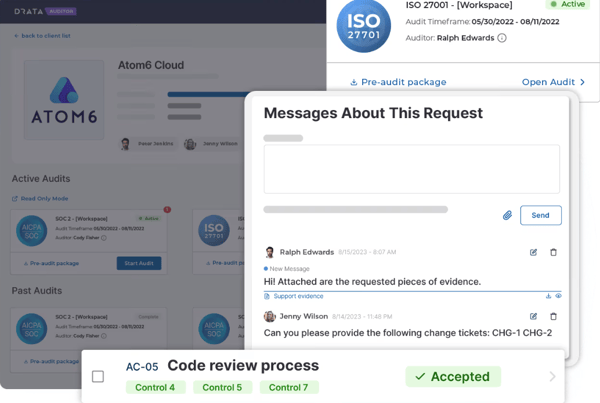
The centralized dashboard was another feature reviewers called out for its clarity and control. It brings all frameworks, controls, and tasks into one unified view, allowing teams to see progress at a glance. For most reviewers, it was the anchor that tied Drata’s automation, integrations, and monitoring capabilities together.
The platform is also widely recognized for being easy to use, even for teams new to compliance automation. Users frequently described its interface as intuitive, clean, and organized. The guided workflows and clear labeling make it simple to assign tasks, track status, and monitor evidence in real time.
Drata’s broad integration coverage offers flexibility and depth but may require additional setup time for teams using niche or legacy systems. While integrations with platforms like AWS, Okta, and Google Workspace were consistently praised for their reliability, some users noted that the initial configuration required extra guidance from the support team. G2 reviewers noted that these challenges typically arose from the tool’s broad coverage and technical depth rather than product limitations. For many, that setup effort was a small trade-off for the long-term benefits of automation and control accuracy.
While its automation features make compliance maintenance seamless in the long term, G2 reviewers mentioned that the transition from manual processes requires some initial adjustment. Teams may need extra time to understand how workflows fit into their existing routines. Reviewers noted that this period is short-lived, and Drata’s guided onboarding, documentation, and proactive support make the process smoother.
If you want to simplify compliance through automation, gain real-time visibility, and maintain readiness across multiple frameworks, Drata stands out as a top choice.
“As a relatively small organisation, Drata has truly been a game-changer for us. Without a large compliance team, we have still been able to make steady progress toward our compliance goals, thanks to the platform. Working alongside a responsive auditing partner, we found the initial implementation straightforward and easy to get started with. The automation features for evidence collection and continuous monitoring have saved us countless hours of manual effort. We rely on Drata daily to ensure that any issues are promptly reported to the appropriate team and resolved quickly. We also value how smoothly it integrates with our core tools, such as AWS, Microsoft 365, and Intune, and how it offers clear dashboards and guided workflows that make preparing for audits much less stressful.”
- Drata review, Keith B.
“Initially, I found it challenging to fully understand how the control framework and evidence were connected, which was confusing. Additionally, there seems to be an inconsistency with the compliance adviser's chatbot responses. Sometimes it answers 'yes' to a question, and other times it says 'no' to the same question, which shakes my confidence in its reliability. I would like this function to be updated regularly to ensure it meets my needs accurately.”
- Drata review, Seren T.
Related: Explore how AI is reshaping trust management and compliance in this conversation with Adam Markowitz, CEO of Drata.
Sprinto holds a satisfaction score of 99 on G2, second only to Vanta. Most of its users come from small businesses (56%) and mid-market organizations (43%), particularly in software, IT, and financial services.
Across reviews, the most consistent theme was Sprinto’s strength in automated evidence collection. The platform continuously gathers and verifies audit evidence from systems like AWS, Okta, and Google Workspace. G2 reviewers stated that this automation eliminated the need for manual screenshots or repeated follow-ups. Teams appreciated that evidence stayed updated automatically, which meant they were always ready for auditor review.
Reviewers consistently highlighted its framework coverage and control mapping. The platform supports major frameworks with shared controls that can be reused across multiple standards. Reviewers said this overlap saved time and prevented duplication when expanding into new certifications.
The platform’s risk monitoring and issue detection stood out in G2 reviews. Sprinto tracks control health in real time and flags potential gaps before they impact audits. Users said this visibility helped them maintain a continuous security posture rather than scrambling close to audit deadlines. Reviewers noted that these automated alerts enhanced coordination among IT, security, and compliance teams.
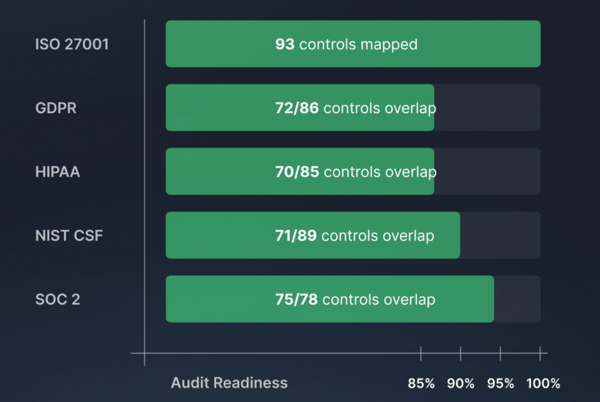
Another strength, frequently noted by reviewers, is Sprinto’s auditor collaboration environment. Auditors can work directly within the platform, reviewing mapped evidence and submitting contextual requests without endless email exchanges. This direct, in-platform communication shortens response cycles and gives compliance teams real-time visibility into audit progress.
Sprinto’s AI-enabled questionnaire module further extends its value. It auto-completes security questionnaires using verified answers from a company’s knowledge base, saving hours of manual work. Teams can upload previous responses, reuse them intelligently, and maintain consistency across RFPs or vendor reviews.
Users consistently praised Sprinto’s customer support for being quick, knowledgeable, and truly committed to their success. Reviewers highlighted that support teams offered both technical and compliance-specific advice, filling gaps for teams lacking in-house experts. Many also noted that their account managers reached out proactively before important audit milestones. The prompt responses and extensive expertise often transformed potentially stressful audits into smoothly managed projects.
Sprinto’s integration coverage focuses on reliability across major systems, which G2 reviewers say makes a strong fit for most teams but slightly restrictive for those with highly customized tech stacks. Some users noted that while integrations with tools like AWS, Okta, and Google Workspace run flawlessly, coverage for niche or regional platforms is relatively limited. Reviewers emphasized that this focus on core systems ensures better data accuracy and fewer sync errors during audits. Teams working in specialized environments may need to handle a few processes manually until broader coverage is added. Still, most agreed that Sprinto’s integration reliability outweighs the narrower scope.
Sprinto’s interface is built for clarity and ease of use, allowing teams to navigate frameworks and tasks without confusion. A few G2 reviewers suggest that refining the visual design could make dashboards feel more modern and dynamic. This feedback points to an opportunity; the foundation is strong, and incremental updates could further elevate user experience. For most teams, the current layout delivers structure and dependability, which remains the platform’s core strength.
All in all, Sprinto is a dependable partner for growing teams that want structure, speed, and confidence in their compliance journey.
“Sprinto’s customer support has truly impressed us. With regular check-ins from our implementation specialists and access to 24/7 messaging support, our questions were answered promptly, allowing us to maintain momentum toward ISO27001 readiness. The platform itself is user-friendly: tasks are clearly organized, progress is simple to monitor, and the implementation process feels manageable, step by step. We also appreciated Sprinto’s robust integrations with our cloud providers, which made monitoring effortless. In the end, Sprinto became the central hub for our entire compliance process, and we depend on it whenever we work on compliance.”
- Sprinto review, Ștefan N.
“While the app is user-friendly, first-time users may still need some time to understand workflows, evidence collection, and integrations."
- Sprinto review, Tippu S.
Related: Explore the best sales tax compliance platforms that help businesses automate calculations, manage filings, and stay compliant across multiple jurisdictions.
Secureframe is a trusted compliance automation platform that makes getting security certifications faster and more manageable. With 96% of reviewers on G2 saying it’s “easy to do business with,” it’s clear that the platform strikes a balance between functionality and simplicity. Most of its users come from small businesses (63%), particularly those in the software, IT, and financial services sectors.
G2 reviewers frequently mentioned Secureframe’s automated evidence collection as one of its strongest advantages. The platform connects with systems like AWS, Google Workspace, and Okta to pull and validate evidence in real time. Users said the continuous verification process ensures compliance gaps are identified early.
Another standout feature is its policy management system. The platform includes a robust library of prebuilt, customizable policies that align with leading frameworks. G2 reviewers appreciated how these templates reduced the time spent creating documents from scratch. Not only that, the tool also has Comply AI for Policies, an AI-powered assistant that helps users revise policies faster by summarizing content, simplifying language, and adjusting tone or structure when needed.
Its control management features are also emphasized for simplifying how teams monitor, assign, and track compliance controls. Reviewers noted that mapping controls across different frameworks minimized duplication and enhanced interdepartmental collaboration. Many noted that Secureframe’s structure allowed them to move from a reactive audit approach to continuous control oversight.
Security awareness training was another highlight in G2 reviews. The platform integrates training modules directly into its platform, helping teams educate employees on compliance and data security best practices. Reviewers said that having training built into the same environment that manages frameworks simplified administration. For organizations seeking to cultivate a culture of compliance, this integration provided a practical and time-saving advantage.
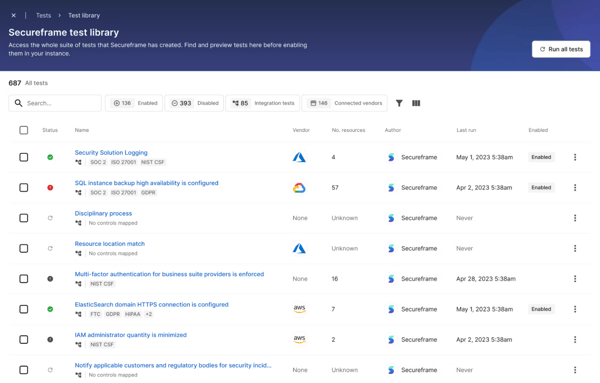
Like other tools in this list, Secureframe also supports multiple frameworks. The platform covers SOC 2, ISO 27001, HIPAA, GDPR, and PCI DSS, allowing teams to manage them all from a single environment. G2 reviewers noted that this flexibility made it easier to scale into new markets or meet industry-specific regulations.
The tool is also valued for its user-friendliness. Users find the interface simple with a low learning curve. Many reported they can easily navigate through frameworks, policies, and dashboards, and they feel the tool makes compliance less daunting.
According to G2 reviewers, Secureframe’s integrations are designed for reliability and audit accuracy. The platform’s focus on stable, pre-validated connections with systems like AWS, Okta, and Google Workspace helps ensure evidence is consistent and audit-ready. Although niche or regional tools may need extra manual setup at the start, once configured, integrations run smoothly.
G2 reviewers noted that the tool’s mobile experience is more limited than its web interface, reflecting its focus on detailed compliance tasks that are better suited for desktop use. Some users mentioned that key tasks, like reviewing dashboards or managing controls, were easier to perform from the main platform. Teams that rely heavily on mobile tools might find this setup restrictive initially, but most agreed that Secureframe’s accuracy on desktops far exceeds the need for mobile parity.
In general, Secureframe is a practical, automation-focused platform offering evidence tracking, guided framework management, and AI-powered policy workflows.
“The reason I like Secureframe is that it has streamlined our SOC 2 compliance process. Previously, it was a lengthy task to maintain controls, gather evidence, and be ready to undertake audits. Much of that work now becomes automatic. We have a good overview of our compliance status through the dashboard, and the reminders keep us on track with all things. Their onboarding staff were also excellent, they took us through setup and ensured that we were conversant with every step. It is very sincere that we have added another member to the team who is committed to compliance.”
- Secureframe review, Brandon N.
“Overall, the platform functions effectively, but I find that the reporting options lack some flexibility. When I need to create audit-ready reports tailored for various internal stakeholders, I often have to make further adjustments outside of Secureframe. This adds a bit of extra work to the process.”
- Secureframe review, Aleix G.
Scrut Automation is a unified security compliance platform that helps organizations automate audits, manage multiple frameworks, and maintain continuous readiness. According to G2 Data, it ranks highest for quality of support at 98% and delivers the shortest estimated ROI, in just 5 months, in this list of tools.
G2 reviewers repeatedly cite automation efficiency as Scrut’s defining strength. The platform automatically collects and validates evidence from cloud infrastructure, HR systems, and ticketing tools, ensuring that controls remain continuously updated. Users highlight that automated workflows significantly shorten audit preparation times for SOC 2 and ISO 27001 certifications, with some noting readiness improvements from several weeks down to days.
The comprehensive compliance coverage is another strong factor. It supports over a dozen frameworks, including ISO 27001, NIST AI RMF, and PCI DSS, all mapped within a single control library. This cross-framework mapping lets teams reuse evidence between certifications instead of maintaining separate documentation trails. Reviewers note that this structure simplifies scaling to new frameworks as the business grows.
The platform also excels in training and policy attestation management. G2 reviewers highlight the ability to assign training, track completion, and log attestations without leaving the Scrut dashboard. Built-in awareness modules help security and HR teams maintain proof of compliance with minimal overhead. Several users note that this integrated training workflow helps establish accountability at every employee level, which is particularly valuable during third-party or external audits where proof of policy acknowledgment is required.
Scrut’s visibility and reporting capabilities are another standout area. Dashboards display audit readiness metrics, overdue evidence, pending controls, and ownership breakdowns in real time. This enables compliance leads and executives to identify any holdups early, distribute workloads more evenly, and monitor performance across departments. The result is a single source of truth for audit readiness.
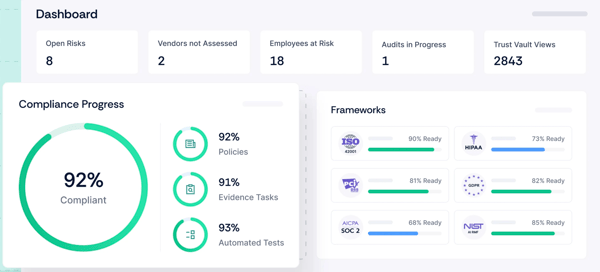
Another consistent theme across G2 Data is the quality of support. Users describe the customer success team as responsive, technically skilled, and proactive about offering tailored guidance. Many reviewers mention that the team’s intervention directly helped them complete audits ahead of schedule or resolve complex control-mapping issues. For smaller teams without dedicated compliance specialists, this level of support translates directly into faster ROI and sustained confidence during audit cycles.
Users acknowledged that Scrut’s interface design has matured considerably over recent updates. G2 reviewers describe the platform as well-organized, with clear navigation between frameworks, risk registers, and reports. Tasks like mapping new controls, reviewing auditor comments, or checking evidence progress are intuitive, even for users with limited prior compliance experience.
G2 reviewers generally find Scrut stable and dependable for everyday compliance tasks. A few note that performance can fluctuate slightly when the platform is processing multiple large audits or heavy evidence uploads. These temporary slowdowns are typically linked to the volume of concurrent automation tasks. Reviewers also emphasize that such instances are short-lived and quickly resolved through support interventions.
The onboarding process is described as methodical and detailed, requiring configuration of frameworks, owners, and integrations before full automation begins. While it may appear time-intensive initially, users recognize it as an intentional setup phase that ensures stability and data accuracy once the system is live. Several G2 reviewers mention that teams completing onboarding with close support achieve smoother automation and fewer manual interventions later.
On the whole, Scrut Automation combines robust automation, broad framework coverage, and one of the strongest customer success records in the category, delivering a measurable ROI.
“Scrut Automation has made compliance management far less stressful for our team. The platform centralizes policies, evidence collection, and audit workflows in one place, saving us a significant amount of time. The dashboard makes tracking progress towards compliance certifications straightforward, and customer support is responsive and knowledgeable.”
- Scrut Automation review, James A.
"There were a few things that I think could have been explained better in the materials. We encountered a few bugs in the platform. Having pre-filled vendor assessments for common vendors like Microsoft Azure and HubSpot would have been helpful.”
- Scrut Automation review, James R.
JumpCloud is a cloud-based directory and identity management platform that extends beyond traditional security compliance use cases. While it isn’t a compliance tool by design, it supports IT and security teams in maintaining centralized control over users, devices, and access policies. According to G2 Data, 32% of JumpCloud’s users are from small businesses and 54% from mid-market companies, primarily in IT, computer software, and network security industries, segments where unified access management is essential for compliance readiness.
Reviewers consistently highlight its centralized user and device management. The platform unifies identity, access, and device controls across macOS, Windows, and Linux environments. Users appreciate the ability to manage authentication, enforce security policies, and monitor endpoints through one dashboard. For compliance-driven teams, this consolidation simplifies data access governance and audit preparation.
Another strength is multi-factor authentication and access policy enforcement. G2 feedback notes that administrators can enforce MFA, SSO, and conditional access controls directly through the console. This capability helps companies meet security frameworks that require identity validation, such as SOC 2 and ISO 27001. Reviewers emphasize that these controls strike a balance between security rigor and employee usability.
Users also praise JumpCloud’s cross-platform flexibility, calling it a rare tool that seamlessly manages mixed device ecosystems. For distributed IT teams, the ability to apply consistent policies across operating systems removes one of the biggest friction points in endpoint compliance. Several reviewers mention that patching, password resets, and policy deployment work equally well on Windows and macOS environments.
The integration ecosystem is another major positive. JumpCloud connects easily with Google Workspace, Microsoft 365, Okta, Slack, and various ticketing and endpoint management solutions. G2 reviewers note that these integrations reduce manual provisioning and centralize access logs, which helps streamline internal audits.
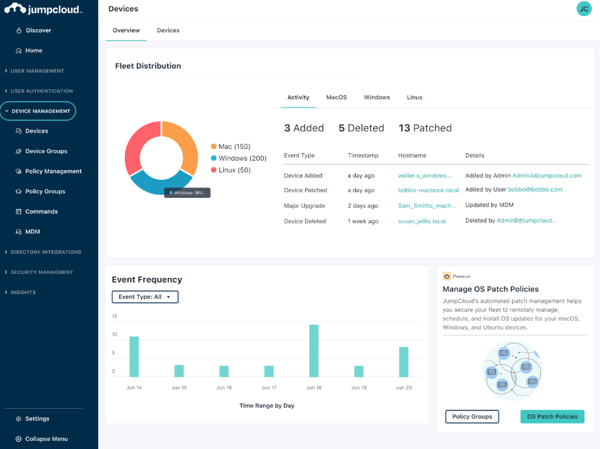
Another aspect users emphasize is ease of use. The admin console is described as straightforward, with clearly labeled sections and an intuitive setup process. Reviewers appreciate how quickly they can deploy security policies, add users, or adjust access rights. This accessibility makes it easier for mid-sized companies to implement and maintain consistent security standards.
The tool earns recognition for its automation capabilities. Reviewers describe automated provisioning, password resets, and device policy enforcement as reliable and scalable. Once configurations are defined, the system applies changes across devices and users automatically, reducing repetitive administrative work. Teams note that this background automation improves compliance consistency and frees IT teams to focus on strategic security planning.
G2 users describe JumpCloud as a powerful enabler for security governance but acknowledge that it lacks native compliance frameworks or evidence-tracking modules. In that sense, the platform is best positioned as part of a broader compliance ecosystem rather than a standalone GRC solution. Teams using JumpCloud for access and device control find it an effective way to satisfy identity-related requirements within security frameworks. For organizations seeking full audit automation, it complements, rather than replaces, dedicated compliance tools.
According to G2 reviewers, JumpCloud’s pricing model is transparent and scalable but benefits from budget planning at higher usage tiers. The per-user structure allows organizations to start small and expand gradually. However, larger environments with extensive endpoint fleets may see costs increase as coverage grows.
Reviewers note that the trade-off is predictable: higher subscription costs result in measurable reductions in manual IT workload and audit preparation time. In practice, most teams view it as an operational investment that scales with organizational maturity rather than an unexpected expense.
JumpCloud ultimately bridges identity management and compliance readiness for IT and security teams who want centralized access control with strong reporting foundations.
“JumpCloud makes it really easy to manage users, devices, and authentication from a single platform. I especially like the centralized identity management with SSO and MFA — it reduces friction for employees while keeping security strong. The UI is clean and intuitive, and integrations with different apps and systems save a lot of time for IT teams.”
- JumpCloud review, Jayshree S.
“There are a few areas that could be improved. The reporting and audit logs, while functional, don’t always go as deep as I’d like when troubleshooting authentication issues. At times, syncing changes across all apps can take longer than expected, which can confuse end users waiting for access updates. I’ve also occasionally run into a situation where users see an “incorrect password” message even though credentials were correct — it usually resolves after a refresh, but it can cause unnecessary tickets. Pricing can also feel a bit high as your user base grows, especially if you need advanced features.”
- JumpCloud review, Prakhar G.
Scytale is a dedicated AI-powered compliance platform that streamlines audits and maintains continuous readiness across 30+ frameworks. According to G2 Data, 72% of its users are from small businesses, primarily in the software, IT, and financial services sectors.
G2 reviewers often describe Scytale as an efficient compliance workspace that consolidates everything from evidence to audit updates into a single platform. Its automation engine works with cloud services, HR systems, and project tools to gather evidence continuously. Users indicate that this reduces manual effort, which typically impedes audits, and guarantees that control mapping remains current.
A major differentiator, as noted in both G2 reviews and industry feedback, is expert-led guidance. Every customer is paired with a dedicated compliance specialist who manages the audit roadmap, advises on control implementation, and ensures a tailored experience from day one. Reviewers highlight that this expert involvement helps demystify the audit process, especially valuable for startups handling their first certification.
The platform also introduces an AI-driven questionnaire feature. Instead of manually responding to repetitive vendor questionnaires, the system uses AI and human review to generate compliant, framework-aligned responses in minutes. Users say this not only saves time but also helps standardize communication with customers and auditors, shortening deal cycles while maintaining accuracy.
Audit Hub is another area G2 users frequently highlight. It creates a shared workspace where auditors, internal teams, and Scytale experts can communicate directly. Evidence requests, approvals, and feedback all live in one thread, eliminating the typical back-and-forth across tools or emails. Reviewers say this collaborative workflow turns what used to be a disjointed process into a single, trackable timeline that keeps everyone aligned until certification.
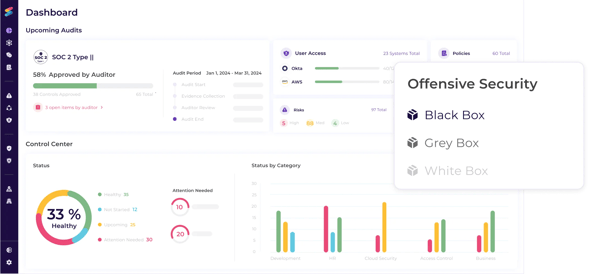
Scytale’s framework mapping and automation depth further strengthen its value proposition. G2 reviewers note that controls can be reused across frameworks, and evidence automatically remaps as companies expand into new certifications. This interoperability is particularly useful for startups scaling quickly across multiple geographies or customer requirements.
Reviewers also mention Scytale’s clarity in progress tracking. Dashboards visualize readiness scores, pending evidence, and control ownership at a glance. For small teams juggling other responsibilities, this structured visibility ensures nothing slips through the cracks.
G2 reviewers describe Scytale’s integration coverage as strong for popular SaaS and cloud tools, though some niche or on-premise systems may still require manual uploads. Users say it reflects Scytale’s focus on fast-moving, cloud-first businesses. The current integrations meet the needs of most teams, and new connectors are rolled out frequently based on customer demand.
Scytale’s dashboards deliver clear visibility into audit progress and control ownership, though teams managing large evidence libraries may notice slightly slower refresh times. This typically appears in multi-framework audits rather than standard workflows. Reviewers note that responsiveness remains consistent for most users and improves steadily with platform updates, and that the trade-off favors real-time clarity over unnecessary interface complexity.
Overall, Scytale blends automation, human expertise, and collaborative audit management in a way that makes enterprise-level compliance achievable for small and growing businesses.
“You feel that they are committed to getting you certified and that they will help you reach that goal. Follow-up/check in meetings were planned, progress was followed, and audits were done. The integrations are good, easy to use, and well documented.”
- Scytale review, Peter V.
“There are minor delays with a few integrations, but their team’s support and responsiveness made up for it.”
- Scytale review, Ian M.
Thoropass combines software-driven tracking with hands-on audit expertise to keep progress visible and documentation under control. According to G2 Data, 76% of Thoropass users are small businesses in the software, IT, and financial services sectors.
The platform’s in-house auditors bring rigor and technical depth to every engagement, helping organizations meet frameworks like SOC 1, SOC 2, HITRUST, PCI, and ISO 27001. Reviewers describe the experience as collaborative, with clear expectations, structured timelines, and a balance between speed and quality.
Thoropass automatically maps controls, gathers evidence, and updates readiness dashboards as changes happen across connected systems. G2 users mention that this ongoing visibility helps keep their compliance programs up to date between audits, and they value being able to see compliance health in real time rather than waiting for quarterly evaluations.
The tool also differentiates itself with built-in penetration testing capabilities. Instead of relying on external vendors, users can perform vulnerability assessments and penetration tests directly through the platform. G2 reviewers note that these tests are not based on generic templates, ensuring reports align closely with real-world environments. This all-in-one approach saves time, maintains consistency, and strengthens overall audit preparedness.
The platform’s AI-assisted audit functionality is another widely praised innovation. Thoropass utilizes AI to pre-screen evidence, identify documentation gaps, and minimize manual QA loops prior to submission. G2 reviewers say this significantly shortens audit cycles, reducing the back-and-forth between teams and auditors.
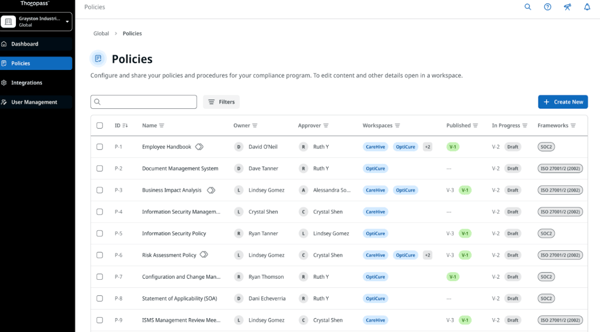
Another feature reviewers highlight is the automation of security questionnaires. Using GenAI, Thoropass reviews a company’s internal library of past responses, policies, and documentation to auto-suggest answers for new questionnaires. Reviewers note that this reduces repetitive work during vendor assessments and sales security reviews, helping teams respond faster without compromising accuracy.
Customer support receives consistent praise in G2 feedback, too. Reviewers describe the support team as proactive, approachable, and deeply knowledgeable about compliance frameworks. Many users say their onboarding and audits ran smoother thanks to responsive guidance and clear communication.
G2 reviewers generally find Thoropass intuitive but mention that certain areas of the interface could benefit from more modern visuals or streamlined layouts. Navigation is functional and reliable, but some users say additional visual cues would make complex audit dashboards easier to scan. Overall, reviewers say that the platform’s strength lies in its structure and clarity. This works well for teams that prioritize workflow reliability over aesthetic minimalism.
Thoropass provides guided onboarding and clear workflows, though some G2 reviewers note that new users may need additional context to understand how each module connects. The training materials cover the basics effectively, but teams new to compliance may want deeper tutorials or more interactive walkthroughs. This approach suits experienced teams looking for flexibility, while first-time users might benefit from extra orientation during initial setup.
In general, Thoropass combines experienced auditing, automation, and intelligent tooling in one place, making it easier for businesses to stay compliant and confident year-round.
“Thoropass proved invaluable in simplifying our SOC 2 compliance journey. It offers a comprehensive range of tools to ensure we have implemented all necessary controls. The platform facilitated a smooth transition with its intuitive interface. The responsive support team provided prompt assistance at every step, enhancing our confidence in our data protection efforts. Overall, Thoropass exceeded our expectations and is an ideal choice for businesses aiming for compliance excellence. We highly recommend it to any organization seeking an effective SOC 2 compliance solution.”
- Thoropass review, Chantale S.
“While Thoropass is a powerful platform, there are a few areas with room for improvement. The UI can sometimes feel a bit cluttered, especially when navigating large sets of controls or evidence items — this can slow down workflows for engineers who want to move quickly. Additionally, some of the integrations, while helpful, occasionally require manual tweaking or don't capture edge-case scenarios automatically.”
- Thoropass review, Juan Carlos T.
Got more questions? We have the answers.
Based on G2 satisfaction scores and verified user feedback, Vanta leads the category. It’s praised for automated evidence collection, continuous monitoring, and clear dashboards that help teams stay audit-ready year-round. Vanta supports frameworks like SOC 2, ISO 27001, HIPAA, and GDPR and currently holds one of the highest satisfaction scores on G2 for usability and automation reliability.
Drata, Vanta, and Scrut Automation are the most trusted by software and IT firms. Drata stands out for continuous control monitoring and auditor collaboration, while Vanta automates multi-framework readiness across environments like AWS, Google Workspace, and Okta. Scrut Automation is also highly rated for risk management, control mapping, and visibility into security posture.
Scrut Automation earns top marks for data protection. It unifies compliance, risk, and security data into one dashboard and supports more than a dozen frameworks, including SOC 2, ISO 27001, and HIPAA. G2 reviewers highlight its automation efficiency, visibility, and 98% quality of support, making it ideal for teams managing sensitive data or regulated environments.
Drata is the top pick for corporate teams due to its scalability, deep integrations, and structured auditor collaboration. G2 reviewers emphasize its real-time monitoring, responsive support, and ability to handle complex, multi-framework environments. For companies seeking managed compliance support, Thoropass is a strong alternative with built-in audit expertise and penetration testing services.
Scytale is highly recommended for small businesses, with 72% of its users on G2 identifying as SMBs. It offers guided onboarding, AI-driven security questionnaire automation, and dedicated compliance experts who simplify complex audits. Vanta and Thoropass are also strong options for growing startups that need automation and expert support.
Secureframe is the most mobile-accessible option in this category. G2 reviewers note that while its mobile interface is more limited than desktop, it allows teams to review dashboards, manage policies, and stay connected to compliance updates on the go. This flexibility makes it practical for teams that need mobile visibility alongside detailed desktop workflows.
JumpCloud is the leading platform for identity and access compliance. It helps IT and security teams manage users, devices, and authentication through one console. With strong support for SSO, MFA, and cross-platform device management, JumpCloud ensures that employee access policies align with compliance frameworks like SOC 2 and ISO 27001.
Sprinto is the top-rated choice for SaaS teams preparing for their first certification. It automates evidence collection, monitors controls in real time, and includes guided workflows that make SOC 2 or ISO 27001 readiness faster. Drata and Vanta also rank highly for scaling SaaS compliance programs across multiple frameworks.
According to G2 Data, Drata and Vanta are the most frequently recommended platforms among technology firms. Both are praised for automation, visibility, and reliability. Sprinto is another popular choice for fast-moving SaaS teams focused on audit readiness and rapid onboarding.
Drata leads the IT segment with robust integrations across AWS, Okta, Microsoft 365, and Jira. G2 reviewers highlight its automation and support for multi-entity compliance programs. JumpCloud is ideal for IT teams managing identity and device access, while Scrut Automation stands out for risk assessment and framework mapping.
Audits and frameworks will always evolve, but managing them doesn’t have to be painful. As regulations tighten and customers demand greater transparency, security compliance software has become less about ticking boxes and more about proving trust through automation, visibility, and collaboration.
The eight platforms featured here: Vanta, Drata, Sprinto, Secureframe, Scrut Automation, JumpCloud, Scytale, and Thoropass, stood out in G2 Data for their real-world impact. Whether it’s continuous monitoring, audit readiness, or managed compliance support, each of these tools helps teams stay ahead of changing standards and reduce audit fatigue throughout the year.
If your compliance process still relies on spreadsheets, screenshots, or last-minute evidence hunts, it’s time to upgrade. These platforms can help your business transition from reactive to always-on compliance, building trust faster, passing audits with confidence, and maintaining security without slowing down growth.
Explore more platforms that unify governance, risk, and compliance in our guide to the best GRC software.
Harshita is a Content Marketing Specialist at G2. She holds a Master’s degree in Biotechnology and has worked in the sales and marketing sector for food tech and travel startups. Currently, she specializes in writing content for the ERP persona, covering topics like energy management, IP management, process ERP, and vendor management. In her free time, she can be found snuggled up with her pets, writing poetry, or in the middle of a Netflix binge.
I’m the kind of person who loves a well-organized system.
.png) by Tanuja Bahirat
by Tanuja Bahirat
Every time I sit down with my InfoSec team, one thing becomes clear: managing governance,...
 by Soundarya Jayaraman
by Soundarya Jayaraman
I’ve always believed chaos is just a sign of a missing system.
 by Harshita Tewari
by Harshita Tewari
I’m the kind of person who loves a well-organized system.
.png) by Tanuja Bahirat
by Tanuja Bahirat
Every time I sit down with my InfoSec team, one thing becomes clear: managing governance,...
 by Soundarya Jayaraman
by Soundarya Jayaraman


